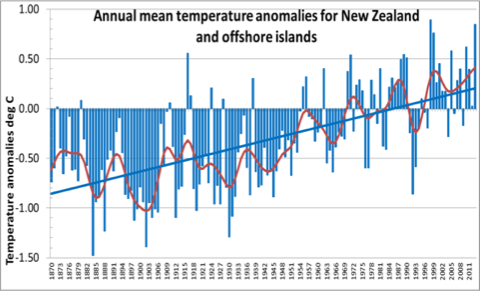 Jim Salinger’s analysis of the climate crank campaign to cast doubt on New Zealand’s long term temperature record, published last week at The Conversation, has drawn an astonishing response ((Web cited so that he can’t “disappear” the evidence.)) from Richard Treadgold (left), the man who kicked off the whole sorry process over four years ago. In an intemperate and libellous comment at his web site, Treadgold accuses Salinger of deception, stupidity and questions his mental stability:
Jim Salinger’s analysis of the climate crank campaign to cast doubt on New Zealand’s long term temperature record, published last week at The Conversation, has drawn an astonishing response ((Web cited so that he can’t “disappear” the evidence.)) from Richard Treadgold (left), the man who kicked off the whole sorry process over four years ago. In an intemperate and libellous comment at his web site, Treadgold accuses Salinger of deception, stupidity and questions his mental stability:
Painting our efforts as some kind of attack on science is stupid. Salinger is either mentally unstable or he’s trying to hide his deceptive treatment of the national temperature records. We asked for details. You’re obviously hiding something if you call that anti-science.
The truth, of course, is that Treadgold and his friends at the Climate “Science” Coalition have spent the last four years quite deliberately attacking Salinger and the science team at NIWA by alleging they acted to deliberately overstate warming in New Zealand. They’ve taken their case to the High Court, and lost. Now they’re running away from facing the legal consequences, by refusing to pay court-ordered legal costs and leaving the NZ taxpayer to foot the bill ((I will have a great deal more to say on this issue, unless and until Barry Brill, Terry Dunleavy, Bryan Leyland and Doug Edmeades pay the costs awarded against their shonky trust)).
This has never been about science. It has always been a political campaign, as Treadgold himself acknowledged when he admitted to the “essentially political objectives of our paper”. Having the lost the argument, he’s now behaving like a spoilt child, throwing a hissy fit at Salinger for telling an uncomfortable truth. His pettiness even extends to posting articles suggesting that Salinger’s affiliations with the Universities of Auckland and Tasmania may be false ((They aren’t.)).
The last line of his typically prolix comment is interesting.
Finally, it’s insufficient that you merely repeat Salinger’s empty allegation of ‘errors’ in our audit. If you want us to respond to the allegation, specify the errors.
The hypocrisy evident here is breathtaking. The “audit” refers to a reconstruction of the NZ temperature record produced by Treadgold’s Coalition pals ((Statistical Audit of the NIWA 7-Station Review, NZCSC, July 2011, available here.)) that was submitted as evidence in their High Court case. Treadgold and the CSC know perfectly well that NIWA found significant errors in that reconstruction, because a detailed description of those errors formed an important part of NIWA’s evidence produced in court.
If Treadgold and the CSC are so sure that their “audit” is faultless, why do they not submit it for peer review at an academic journal? I’m sure that Chris de Freitas, never averse to lending his academic weight to the climate crank cause, would be willing to act as lead author and help to usher it past peer review, as he has done for so many papers over the years. I hear that Pattern Recognition in Physics could have a new publisher who might be interested. In the meantime, if Treadgold has any sense of decency he will apologise to Salinger for so maligning an honest man. Past history would suggest that I should not hold my breath.

 NZ temperature expert Jim Salinger has been crunching last year’s data, and this morning
NZ temperature expert Jim Salinger has been crunching last year’s data, and this morning 
